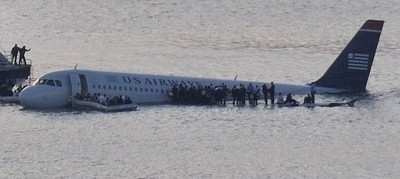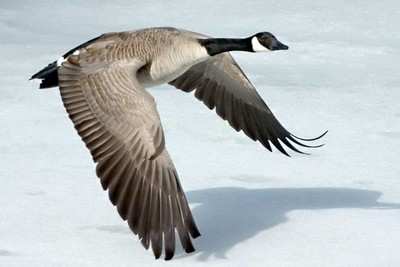Smithsonian Studies Bird Remains To Detemine Origins
 Scientists at the
Smithsonian Institution have examined the feather remains from the
Jan. 15 US Airways Flight 1549 bird strike to determine not only
the species, but also that the Canada geese involved were from a
migratory, rather than resident, population. This knowledge is
essential for wildlife professionals to develop policies and
techniques that will reduce the risk of future collisions. The
team's findings are being published in the journal "Frontiers in
Ecology and the Environment."
Scientists at the
Smithsonian Institution have examined the feather remains from the
Jan. 15 US Airways Flight 1549 bird strike to determine not only
the species, but also that the Canada geese involved were from a
migratory, rather than resident, population. This knowledge is
essential for wildlife professionals to develop policies and
techniques that will reduce the risk of future collisions. The
team's findings are being published in the journal "Frontiers in
Ecology and the Environment."
The US Airways plane took off from New York's LaGuardia Airport,
colliding with a flock of geese approximately 2,900 feet above the
ground, extensively damaging both engines five miles from the
airport. The pilot was able to conduct an emergency landing in the
Hudson River -- all 155 people on board survived with few serious
injuries. Investigators at the National Transportation Safety Board
later sent feathers and tissue extracted from the plane's engines
to the Smithsonian in Washington, D.C., for analysis.
Researchers in the Feather Identification Laboratory at the
Smithsonian's National Museum of Natural History used molecular
genetic techniques and feather samples from museum collections, as
well as a technique developed for rapid species identification with
small genetic samples called DNA barcoding, to determine that the
birds involved were Canada geese (Branta canadensis). This is one
of the largest species of birds in North America, and the
individual birds involved are estimated to have weighed about 8
pounds.

The next step for the scientists was to find out if these geese
were migratory or non-migratory (resident) birds. "Determining
whether these birds were migratory or not was critical to our
research and will help inform future methods of reducing bird
strikes," said Peter Marra, research scientist at the Smithsonian's
Migratory Bird Center located at the National Zoo and lead author
of the project's paper. "Resident birds near airports may be
managed by population reduction, habitat modification, harassment
or removal, but migratory populations require more elaborate
techniques in order to monitor bird movements."

The team took their research to a molecular level at the
Smithsonian's Museum Conservation Institute labs in Suitland, Md.,
where they examined stable-hydrogen isotopes from the feathers to
confirm whether the geese were from resident or migratory
populations. Stable-hydrogen isotope values in feathers can serve
as geographic markers since they reflect the types of vegetation in
the bird's diet at the time it grew new feathers after molting.
Using a mass spectrometer, which measures the masses and relative
concentrations of atoms and molecules at high precision, the
scientists compared the bird-strike feather samples with samples
from migratory Canada geese and from resident geese close to
LaGuardia Airport. Analysis revealed that the isotope values of the
geese involved in the crash of Flight 1549 were most similar to
migratory Canada geese (shown below, courtesy of Chuck Szmurlo)
from the Labrador region and significantly different from resident
feathers collected in New York City.
"It is important to not only know what species of birds are
involved in collisions, but to also understand the role that
migration plays in the larger picture," said Carla Dove, program
director at Feather Identification Laboratory. "The more
information we are able to gather in cases like this, the more we
will be able to reduce the risks of bird strikes in the
future."
Although reporting bird strikes is not currently required by the
FAA, it is critical for researchers, according to Marra. "Knowing
the frequency and timing of collisions is important," he said.
"Otherwise we are missing valuable information that could reveal
patterns of frequency, location and species involved." Integrating
this information with bird migration patterns and existing wildlife
mitigation programs at airports could minimize the risk of
collisions with birds.

Ultimately, the team's research demonstrated how molecular
genetic tools and stable-hydrogen isotope analyses can be applied
in a forensic fashion to provide essential, detailed data on the
species involved and their geographic origin -- information that is
essential to develop strategies to avoid such human-wildlife
conflicts in the future. Aviation is not the only field that may
benefit from this type of scientific research, however. The team
believes their methods could also be applied when birds (and bats)
strike and are killed by cell-phone towers, wind turbines,
buildings and oil platforms.
 ANN's Daily Aero-Linx (05.06.25)
ANN's Daily Aero-Linx (05.06.25) ANN's Daily Aero-Term (05.06.25): Ultrahigh Frequency (UHF)
ANN's Daily Aero-Term (05.06.25): Ultrahigh Frequency (UHF) ANN FAQ: Q&A 101
ANN FAQ: Q&A 101 Classic Aero-TV: Virtual Reality Painting--PPG Leverages Technology for Training
Classic Aero-TV: Virtual Reality Painting--PPG Leverages Technology for Training Airborne 05.02.25: Joby Crewed Milestone, Diamond Club, Canadian Pilot Insurance
Airborne 05.02.25: Joby Crewed Milestone, Diamond Club, Canadian Pilot Insurance






